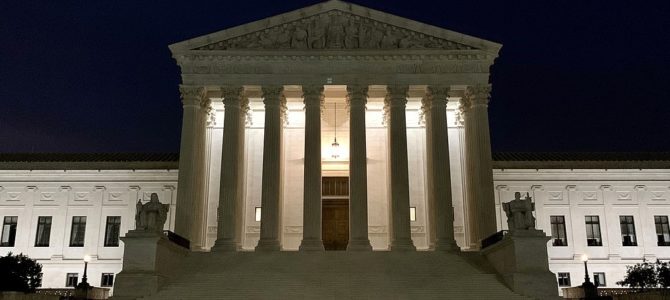
The Supreme Court is expected to soon hear New York State Rifle & Pistol Association (NYSRPA) v. Bruen, challenging a New York law that allows judges and police commissioners to deny licenses, to carry handguns for self-defense away from home, to applicants they deem do not have “proper cause.”
As a result, applicants who want to exercise “the individual right to possess and carry weapons in case of confrontation,” as the Supreme Court put it in District of Columbia v. Heller (2008), are routinely turned down. New York is one of eight heavily Democrat states with this sort of law, the others being California, Delaware, Hawaii, Maryland, Massachusetts, New Jersey, and Rhode Island.
A Brief History Of State Carry Laws
In “The Right To Bear Arms: A Constitutional Right Of The People Or A Privilege Of The Ruling Class?,” Second and Fourteenth Amendment scholar Stephen P. Halbrook shows that in this part of the world, from day one until well after the Second Amendment’s ratification, carrying handguns and other arms for protection, concealed or openly, away from home (without a license) was lawful, thus within the scope of the right to arms as understood by the Framers of the Constitution and Bill of Rights.
However, in the 1800s, state legislatures began prohibiting the carrying of weapons concealed, state courts mostly let them get away with it—an exception being the Kentucky Supreme Court, in Bliss v. Commonwealth, 1822—and into the 20th century most states kept those blanket prohibitions or prohibited carrying without a license that officials generally refused to issue.
Most of those states have since switched to “shall issue” laws, which require that licenses be issued to applicants who meet objective standards concerning their age, lack of a criminal record, and so on. Today, 41 states are “shall issue,” Vermont has never prohibited or required a license for carrying concealed or openly, and those 42 states account for three-fourths of the nation’s population.
Twenty of the 41, plus Vermont, have “constitutional carry” laws, so named because, as during the founding era, they don’t prohibit or require a license for carrying a handgun concealed or openly. (The 20 states have licensing systems for people who, during travel, carry in states that require licenses.) Fifteen states require a license to carry concealed, but not openly.
How the Supreme Court Makes Sausage
In July, a conservative commentator wrote that we should be happy that the Supreme Court is less bad now than at any time during the last 50 years. Another view is that we live in the present, thus should support the court when it rules correctly and oppose it when it rules incorrectly or refuses to rule out of fear of Democrats’ court-packing and term-limit threats, or because no one on the court is comfortable with Americans being armed to the extent the Framers intended.
We may find out which view of the court is more insightful in NYSRPA. If there are five justices who care about original intent, New York will lose, because its law is at odds with the Second Amendment’s text and legislative history, and the history of the right to arms leading to the amendment’s adoption, and it denies New Yorkers their Fourteenth Amendment right to equal protection under the law.
But that’s a big “if.” In Heller, Chief Justice John Roberts and Justices Samuel Alito and Clarence Thomas were part of the majority that rejected original intent to justify banning guns quintessentially within the scope of the right to arms.
They began with the court’s confused opinion in U.S. v Miller (1939). Miller correctly recognized that the Second Amendment guarantees an individual right not limited to militiamen, but incorrectly suggested the right is limited to arms that “have some reasonable relationship to the preservation or efficiency of a well regulated militia.”
Adding to the confusion, it suggested that examples of such arms include “ordinary military equipment” (which includes “machineguns,” federal law’s catch-all for machine guns and all other fully automatic firearms), but also any other arms that could “contribute to the common defense,” which would mean all arms. Miller also noted the obvious, that militiamen commonly owned arms “in common use.”
Heller came to the court from the U.S. Court of Appeals for the District of Columbia Circuit, where it was known as Parker v. District of Columbia (2007). Parker correctly struck down D.C.’s handgun ban, but on the wrong basis, saying that because “handguns are ‘Arms’ referred to in the Second Amendment, it is not open to the District to ban them.” It reached that conclusion because handguns were common in the founding era, militia officers were required to have them by the second Militia Act of 1792, and “[t]he modern handgun (is) a lineal descendant of that founding-era weapon, and it passes Miller’s standards.”
Parker’s error was twofold: First, while handguns were common in the founding era and modern handguns are their lineal descendants, that’s not why banning them is unconstitutional. The Framers adopted the Second Amendment to guarantee the right to “arms” as a means to an end—“the security of a free State” against tyranny and, it went without saying, common criminals and other threats. The distinction is important because, in the future, guns as we know them will be useless for defense against tyranny, and the only arms that will be useful will have no lineage to arms known during the founding era.
Second, knowing what arms founding-era militiamen possessed may be interesting to Revolutionary War reenactors, antique gun collectors, and historians, but it doesn’t limit “the right of the people,” and to the extent “Miller’s standards” suggest otherwise, Parker should have ignored them.
What Arms Government Can Ban
The burden of proof when challenging a gun ban should not be upon plaintiffs to show why they should be allowed to have the gun (e.g., version of a founding-era gun), it should be upon them to show why the government doesn’t have the power to ban it, or upon the government to show why it has that power. In June, Judge Roger Benitez ruled the latter in Miller v. Bonta, striking down California’s “assault weapon” ban, saying “[t]he command of the Amendment is that the right to keep and bear arms ‘shall not be infringed.’ It . . . is the government that must carry the burden of justifying its restriction of Second Amendment rights.”
However, even if the burden is upon plaintiffs, it’s easy to bear. While the Framers understood that privately kept arms had always been used for defense against common criminals, the amendment’s political objective was to protect the constitutional order against tyranny.
Thus, the only arms the government may ban are those that would give an individual a degree of power against modern tyrannical enemies significantly greater than the degree of power an individual in the founding era had with his arms against the tyrannical enemies of his day—arms that would give an individual a degree of tyranny-fighting power the Framers intended to be distributed among “the people.”
Unbanning Handguns By Banning ‘Machineguns’
In his brief in Heller, then-Solicitor General Paul Clement (now counsel for petitioners in NYSRPA) complained that under Parker’s standard, the 1986 ban on new “machineguns” might be unconstitutional, because M16s (which, though not machine guns, can fire fully automatically) are the most common guns in the organized militia (the National Guard). During oral arguments, Clement added, “I think it is more than a little difficult to say that the one arm that’s not protected by the Second Amendment is that which is the standard issue armament for the National Guard.” In other words, to justify banning M16s, the court would have to get creative.
Heller was about handguns, not “machineguns,” and the court should have said so. Instead, the majority caved to Clement and, before dealing with the former, went after the latter.
Read in isolation, Miller’s phrase ‘part of [the] ordinary military equipment’ could mean that only those weapons useful in warfare are protected. That would be a startling reading of the opinion, since it would mean that the National Firearms Act’s restrictions on machineguns . . . might be unconstitutional. . . . Miller’s ‘ordinary military equipment’ language must be read in tandem with what comes after: ‘[O]rdinarily when called for [militia] service [able-bodied] men were expected to appear bearing arms supplied by themselves and of the kind in common use at the time.
The court was wrong. First, there was no need to read any part of Miller “in isolation.” Miller endorsed the right to “ordinary military equipment,” such as “machineguns,” but also to other arms that could “contribute to the common defense.”
Second, it’s not only the National Firearms Act’s (1934) registration and tax provisions the constitutionality of which might be threatened. The Gun Control Act (1968) prohibits the same guns’ importation, the McClure-Volkmer Act (1986) prohibits their domestic manufacture, and about half the states prohibit their possession.
Third, Heller didn’t read Miller’s parts “in tandem.” It ignored Miller’s endorsement of the right to military and all other arms that could be used for the common defense, and accepted only its observation that militiamen commonly owned commonly owned guns.
On that basis, it claimed “machineguns” can be banned because they aren’t common, despite being the most common guns in the organized militia. And while it’s true they’re not common among the unorganized militia and “the people” generally, the court neglected to explain why: the federal and state laws mentioned in the previous paragraph.
Finally, whether to apologize or to add insult to injury, the court admitted it was at odds with the Framers’ intent:
It may be objected that if weapons that are most useful in military service—M-16 (sic) rifles and the like—may be banned, then the Second Amendment right is completely detached from the (amendment’s) prefatory clause. . . . But the fact that modern developments have limited the degree of fit between the prefatory clause and the protected right cannot change our interpretation of the right.
If Justices Neil Gorsuch, Brett Kavanaugh, and Amy Coney Barrett join Chief Justice Roberts and Justices Alito and Thomas in thumbing their noses at the Framers in NYSRPA, like the latter three did in Heller, the court will deserve to go down not as the least bad of the last 50 years, but as one of the most anti-constitutional activist courts in American history.









